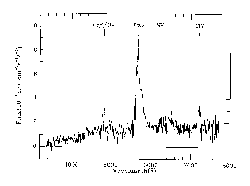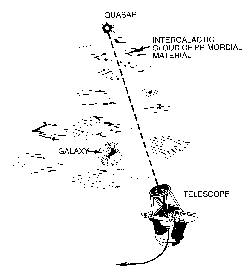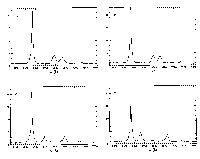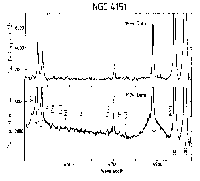|
 Quasi-stellar
objects, or quasars, are the most luminous sources in the universe. Most
astronomers now share the view that quasars are the nuclei of distant galaxies
where energetic processes, such as accretion of gas by a massive black
hole, produce more light than the total amount emitted by all the stars
in the galaxy (a typical galaxy contains about one hundred billion stars
as luminous as our Sun). Because of the still mysterious nature of their
central 'power-houses', quasars are objects of great interest at present.
However, in recent years astronomers have devoted large efforts to the
study of quasar spectra for an entirely different reason. Quasi-stellar
objects, or quasars, are the most luminous sources in the universe. Most
astronomers now share the view that quasars are the nuclei of distant galaxies
where energetic processes, such as accretion of gas by a massive black
hole, produce more light than the total amount emitted by all the stars
in the galaxy (a typical galaxy contains about one hundred billion stars
as luminous as our Sun). Because of the still mysterious nature of their
central 'power-houses', quasars are objects of great interest at present.
However, in recent years astronomers have devoted large efforts to the
study of quasar spectra for an entirely different reason.
Being so luminous, quasars can
be observed over much larger distances in the universe than any other class
of object. We now know that the universe we live in is expanding in a manner
analogous to a balloon being inflated - the further two points are on the
surface of the balloon, or two galaxies in the universe, the faster the
distance between them increases with the expansion, and therefore the faster
they recede from one another. Proof of the extremely high velocities of
recession of quasars is readily provided by the very high red-shifts of
their spectra. As an example of this, Fig. 1 shows
the optical spectrum of a quasar identified by Boksenberg and Sargent with
the Isaac Newton Telescope (the object was recognized as a quasar
candidate by C. Hazard and R. McMahon.) The most obvious feature
in the spectrum is the broad emission line of neutral hydrogen labelled
Lyman-alpha. The rest wavelength of this line - that is the wavelength
at which it would be recorded in objects at rest relative to an observer
on Earth - is 1216 Å, in the far ultraviolet. In this quasar,
the same spectral line is instead observed at 5691 Å implying that,
since the time when the quasar light was emitted, the universe has increased
in linear size in the same proportion as the wavelength of the Ly-alpha
photon, that is by a factor (5691/1216) = 4.68 = (1 + z). At a redshift
z=3.68, this quasar is one of the most distant objects in the universe
known to date.
 Because
of the tremendous distance over which the quasar photons have travelled,
the time taken to reach the Earth is a large proportion (about 9/10) of
the total time since the expansion of the universe began. Furthermore,
in its journey to the INT on La Palma, the light from the quasar has passed
through intervening matter in the universe, matter which is too distant
to be observed directly, but which has left its characteristic signature
in the quasar spectrum in the form of absorption lines. It is easy
to see now the importance of quasars as 'cosmic beacons': their spectra
offer a unique oportunity to view the universe at much earlier times and
provide clues as to how its properties have evolved over a significant
fraction of its history. Because
of the tremendous distance over which the quasar photons have travelled,
the time taken to reach the Earth is a large proportion (about 9/10) of
the total time since the expansion of the universe began. Furthermore,
in its journey to the INT on La Palma, the light from the quasar has passed
through intervening matter in the universe, matter which is too distant
to be observed directly, but which has left its characteristic signature
in the quasar spectrum in the form of absorption lines. It is easy
to see now the importance of quasars as 'cosmic beacons': their spectra
offer a unique oportunity to view the universe at much earlier times and
provide clues as to how its properties have evolved over a significant
fraction of its history.
Over the last five years there
have been several major steps forward in our understanding of quasar absorption
spectra, made possible in large part by the availability of a new type
of detector - the Image Photon Counting System (IPCS), developed jointly
by University College London and RGO. The IPCS is particularly efficient
at detecting faint light signals with the maximum possible accuracy; this
is especially important for QSO absorption line work, since both high-spectral
resolution and photometric accuracy are necessary to register the weak
and narrow absorption lines seen in the spectra of generally faint quasars.
It now appears that there are
at least two kinds of absorption lines, formed in physically distinct intervening
regions. In a typical quasar spectrum most of the lines at wavelengths
longer than the emission Ly-alpha line can be readily grouped in well-defined
absorption systems, with all the lines within a system appearing at the
same redshift, generally lower than that of the quasar itself. These lines
can be convincingly identified with those of the most abundant elements
- such as H, C, N, O and heavier species, up to and including Fe and Zn
- in the stages of ionization prevalent in the interstellar medium of our
Galaxy. Furthermore, the metal-line systems are clustered in redshift
in a manner consistent with the present-day clustering of nearby galaxies.
Thus, it appears that they are most likely formed in intervening haloes
of galaxies randomly distributed in line of sight to the quasars. This
in turn implies that galaxies possess tenuous gaseous haloes extending
far beyond their optical dimensions, a conclusion supported by recent ultraviolet
observations of the halo of our own Galaxy. Another important result deduced
from studies of the quasar metal-line systems is that in a few cases where
it has been measured with the required accuracy, the chemical composition
of the interstellar gas in these distant galaxies has been found to be
similar to that of the interstellar medium near our own Sun. This indicates
that even when the universe was only 1/10 of its present age, at least
some galaxies had already undergone a significant amount of metal enrichment
via stellar nucleosynthesis.
The second class of quasar absorption
lines is found only at wavelengths shorter than the emission Ly-alpha and
consists of single Ly-alpha absorption lines, with no obvious associated
heavy-element lines. These Ly-alpha lines are far more numerous, by a factor
of about 50, than the metal-line systems. Furthermore, they are not
clustered like galaxies, leading to the suggestion that they represent
an intergalactic population of primordial clouds. Much effort is currently
being directed towards determining stringent upper limits to the metallicity
of the Ly-alpha clouds. If this is indeed pristine gas, which has not condensed
to form stars, it should still bear the imprint of the original composition
determined by nucleosynthesis in the early universe and can thus
serve as a powerful test of the predictions of the hot Big-Bang model.
One result which has now been established beyond doubt is that the comoving
density of the Ly-alpha clouds exhibits a marked cosmological evolution,
in the sense that the clouds became progressively less abundant as the
universe expanded. This result has important implications for a problem
of much current interest: how structure, in the form of galaxies, clusters
and superclusters, formed and evolved from an initially smooth universe.
| More
information
ING facilities involved:
-
Isaac Newton Telescope,
using IPCS detector on the IDS spectrograph.
Pictures:
Some references:
-
Hazard, C. and McMahon,
R., 1985, "New Quasars with z=3.4 and 3.7 and the surface density of very
high redshift quasars", Nature, 314, 238.
-
Pettini, M. and Boksenberg,
A., 1985, "From Here to Quasars", RGO Telescopes, Instruments, Research
and Services October 1 1980-September 30 1985, 8.
-
Steidel, C., Sargent,
W. L. W., Boksenberg, A., 1987, "The clustering of high redshift metal
line absorption systems", High redshift and primeval galaxies; Proceedings
of the Third IAP Workshop, Paris, France, June 29-July 3, 1987, Editions
Frontieres, 391.
|
|






